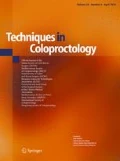Abstract.
Sacrococcygeal pilonidal disease is a common and well recognized entity. For many years the cause of sacrococcygeal pilonidal sinus has been matter of debate. When the treatment is considered, there was a frequent lack of succes of the surgical methods of excision regarding morbidity, healing, recurrence and cure. All these factors rendered the acquired thesis of pilonidal sinus disease to be more accepted. In dealing with the pathogenesis of pilonidal sinus disease, Karydakis attributed the hair insertion process to three main factors: the invader, i.e. the loose hair; the force, which causes the insertion; and the vulnerability of the skin to the insertion of hair at the depth of the natal cleft. The sinus is initiated from a small midline opening lined by stratified squamous epithelium. Additional sinuses are frequent and have lateral openings. Malignant transformation is rare but cases of squamous cell carcinoma and verrucous carcinoma have been reported. Pilonidal sinus disease consists in a symptoms complex with presentations ranging from asymptomatic pits to painful draining lesions that are predominantly located in the sacrococcygeal region. Asymptomatic pits do not require treatment. Options for treatment of acute abscess include aspiration, drainage without curettage, and drainage with curettage. The choice of a particular surgical approach depends on the surgeon's familiarity with the procedure and perceived result in terms of low recurrence of sinus and a quick healing of resulting cavity or surgical wound. Conservative nonoperative management, closed methods, laying of track, wide excision and open drainage, wide excision and primary closure, and limited excision are the methods currently used. From the profusion of studies, it is apparent that various methods are being tried and no one method is universally acceptable. Recurrence rates vary with the technique, operator and length of follow-up. Primary closure with a lateral approach appears to give the best results.
Similar content being viewed by others
Author information
Authors and Affiliations
Additional information
Received: 16 December 2002 / Accepted: 13 January 2003
Correspondence to N. Haboubi
Rights and permissions
About this article
Cite this article
Chintapatla, S., Safarani, N., Kumar, S. et al. Sacrococcygeal pilonidal sinus: historical review, pathological insight and surgical options. Tech Coloproctol 7, 3–8 (2003). https://doi.org/10.1007/s101510300001
Issue Date:
DOI: https://doi.org/10.1007/s101510300001



